You are using an out of date browser. It may not display this or other websites correctly.
You should upgrade or use an alternative browser.
You should upgrade or use an alternative browser.
History, Mythology, Art and RPGs
Galloglaich
First Post
Yeah I agree... I think part of that is because we have been (as a community) studying "German" longsword pretty intensively for about 12 years now, and the fundamentals are pretty well understood at this point. When it comes to more advanced techniques we are still sanding off the rough edges though.
Messer and dagger have probably only had serious systematic study for around maybe 5 years, sword and buckler has only come up to speed (of people understanding the basics) in the last 3 years or so, and Poll Axe is still kind of in it's infancy in terms of interpretation. Those fencing manuals can be pretty counter-intuitive and it takes a lot of people working really hard to begin to get a grip on them.
G.
Messer and dagger have probably only had serious systematic study for around maybe 5 years, sword and buckler has only come up to speed (of people understanding the basics) in the last 3 years or so, and Poll Axe is still kind of in it's infancy in terms of interpretation. Those fencing manuals can be pretty counter-intuitive and it takes a lot of people working really hard to begin to get a grip on them.
G.
Galloglaich
First Post
a really interesting look at how Europeans were percieved by Japanese and Chinese artists in the time of first- contact
Res Obscura ☽ ▩ ☼: Europeans as 'Other'
Res Obscura ☽ ▩ ☼: Europeans as 'Other,' Redux


http://3.bp.blogspot.com/_bOmMbyE0UnI/TAxaoTV7BUI/AAAAAAAAAH8/CwrZnn-jEPU/s1600/port2.jpg
Res Obscura ☽ ▩ ☼: Europeans as 'Other'
Res Obscura ☽ ▩ ☼: Europeans as 'Other,' Redux

http://3.bp.blogspot.com/_bOmMbyE0UnI/TAxaoTV7BUI/AAAAAAAAAH8/CwrZnn-jEPU/s1600/port2.jpg
Galloglaich
First Post
Imagine this as a scenario for a fantasy film. In a Medieval Kindgom, a bandit has been captured and convicted of a felony. The laws of this Kingdom are harsh, his sentence is death. But he is offered a deal: fight his former accomplices on behalf of the Crown, and sentence will be commuted. The man fights judicial combats against several local bandits, and slays them. He is spared the gallows and put on the payroll with title of "Approver", a duelist who fights for the Kingdom.
As an "Approver", he is accompanied by another man called a "Magister", and the two travel to a neighboring county, challenge known criminals there, and kill them in judicial combat. Then they continue to travel the countryside, slaying the wicked, and bringing justice to a Wild land.
That is not a fantasy story, it's historical fact. The Medieval Kingdom in question was England, the year was 1160 AD, the bandits name was Evrard, and records of his payments have been found by researchers.
It is not certain what the precise status of the 'Magister' was. Several 'Approvers' were accompanied by a 'magister' whom scholars originally took for a kind of manager or a Crown prosecutor. But some of the cases show that the 'magister' was a former champion rather than an attorney, which means they may have actually been a travelling fight-instructor. Like something right out of a Samurai movie.
Special thanks to Ariela Emena for this research.
Professional duelists in Medieval Europe
So we know that most of the fencing manuals surviving today are for Judicial combat. But the fencing manuals we have today are from the 14th Century or later, (almost all of them are from the 15th Century or later) we don't know much of the early history of the European Martial Arts or it's role in Judicial combat, if any, during the Medieval period.
Roland Warzecha, a fencing instructor and researcher from the group Hammaborg in Germany, posted an interesting description of another type of professional duelist in Medieval Germany called a "Kemphe". I'll quote him here in his own words:

This may be a portrait of the famous Renaissance fencing Master Hans Talhoffer himself.
Working as an 'Approver' or a 'Kemphe' was dangerous business, Judicial Combat was no joke. Illustrations in the 15th Century manuals make that abundantly clear.


It was not unusual for the Church to participate in Judicial combat either. Roland Warczecha pointed out a couple of incidents which exist in period records:
As an "Approver", he is accompanied by another man called a "Magister", and the two travel to a neighboring county, challenge known criminals there, and kill them in judicial combat. Then they continue to travel the countryside, slaying the wicked, and bringing justice to a Wild land.
That is not a fantasy story, it's historical fact. The Medieval Kingdom in question was England, the year was 1160 AD, the bandits name was Evrard, and records of his payments have been found by researchers.
-Great Roll of the Pipe for the Sixteenth Year of Henry the Second, Pipe Roll Society (Old Series) vol. 15, p. 34.In the payment of Evrard the approver and for his contract for three eyres through England, 24 s., 6 d. Also for his arms. And payment to Peter of Saint-Lô, who taught him, 56 s., 8 d. And also to the same Peter, 3 s.
It is not certain what the precise status of the 'Magister' was. Several 'Approvers' were accompanied by a 'magister' whom scholars originally took for a kind of manager or a Crown prosecutor. But some of the cases show that the 'magister' was a former champion rather than an attorney, which means they may have actually been a travelling fight-instructor. Like something right out of a Samurai movie.
Special thanks to Ariela Emena for this research.
Professional duelists in Medieval Europe
So we know that most of the fencing manuals surviving today are for Judicial combat. But the fencing manuals we have today are from the 14th Century or later, (almost all of them are from the 15th Century or later) we don't know much of the early history of the European Martial Arts or it's role in Judicial combat, if any, during the Medieval period.
Roland Warzecha, a fencing instructor and researcher from the group Hammaborg in Germany, posted an interesting description of another type of professional duelist in Medieval Germany called a "Kemphe". I'll quote him here in his own words:
The first school teaching sword and buckler in England is recorded as early as the late 12th century. At least from the thirteenth century onwards 'Schirmen' (which is sword fighting) was often tought by a 'schirmmeister'. He might have held an according office at a lord's court (though possibly only temporarily) or he could have been hired to train a contender for judicial combat. A schirmmeister was apparently held in much higher esteem than a hired kemphe (champion) who fought in a contender's stead. It is interesting to note that some regulations require the accuser to pay for his training himself while the accused party was to be provided with according training and weapons by the authority in charge of the law suit. To this end, a fencing master would have had to be hired by the authorities.
I would like to add that the hiring of a schirmmeister to prepare a fighter for judicial combat is well recorded by Master Talhoffer himself in the 15th century. Though in his case the fighter was also the employer.
The training and preparation for an ordeal by combat was called a lertag and usually lasted six weeks.

This may be a portrait of the famous Renaissance fencing Master Hans Talhoffer himself.
Working as an 'Approver' or a 'Kemphe' was dangerous business, Judicial Combat was no joke. Illustrations in the 15th Century manuals make that abundantly clear.


It was not unusual for the Church to participate in Judicial combat either. Roland Warczecha pointed out a couple of incidents which exist in period records:
Nor was it unheard of for Women to fight in Judicial combats. But more about that later.in one incident, following the murder of an abbot, the monks were preparing themselves to fight out the strive. In another case, an abbot had hired a champion to fight for his cause. It actually appears that the clerics where rather forcing to settle the matter by judicial combat because they considered their case too weak to win the law suit in a different way. The 'kemphe', however was eventually killed in the fight and the abbot lost his case.
Last edited:
Love of Awesome
First Post
I haven't seen this one yet anywhere on here, so i'll just make my contribution. If it has been done than just tell me.

George Washington 1732-1799 (67 years old) LG
Farmer, Soldier (Officer), Politician, General of the continental army, helped to lead the United States to victory against the British, and was the first president of the United States.
George Washington - Wikipedia, the free encyclopedia

George Washington 1732-1799 (67 years old) LG
Farmer, Soldier (Officer), Politician, General of the continental army, helped to lead the United States to victory against the British, and was the first president of the United States.
George Washington - Wikipedia, the free encyclopedia
Galloglaich
First Post
He wouldn't make the list for a few reasons (mainly because he is too famous, he's a household name) but not many people know Washington was a remarkable soldier on a personal level in that he was considered amazingly lucky in battle not to be killed. He apparently survived having several horses shot out from under him during the French - Indian war and had bullets shoot through his hat and his coat on more than one occasion, in spite a career of warfare he lived a long life.
G.
G.
Galloglaich
First Post
On another forum, someone asked:
So Who Were the Franks
The late Frankish kingdom was a complex society, not really feudal in the 10th Century so much as still mostly tribal. Due to the relative paucity of surviving records we actually know far less about them than we do about the Romans or the later Medieval world. But we do know a few things I can review briefly here.
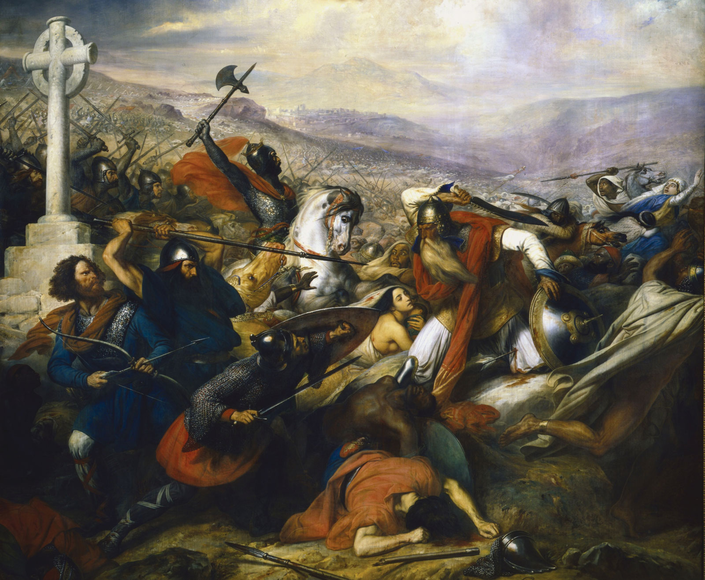
Charles Martel vanquishes the Moors at Tours in 732 AD
The Frankish top leadership (the Carolingian Dynasty) was very strong in the 8th Century from the victory of Charles Martel at Tours until the early 9th Century when Charlemagne died. During Charlemagnes reign the King of the Franks also became the Emperor of 'Rome'. After Charlemagnes death the Empire was split into three parts and the Frankish kingdom went into a period of decline through the 9th Century under a series of weak leaders with names like Charles the Fat, Charles the Simple and Louis the Stammerer. France was ravaged by the Vikings and fragmented by internal dissent well into the 10th Century. Meanwhile the other two branches of the Empire, Burgundy / Italy and Germany, went into a different direction, sealing the break up of the Frankish Empire into several parts by the late-9th Century. Finally from the early 11th Century the Capetians took over starting with Hugh Capet, which was a new stronger dynasty leading into the Medieval Kingdom of France. So that is the top leadership, complex enough to be sure, but that is actually the simplest part.
Probably the most important fact to keep in mind about the Franks is that they were not an ethnic group per se, or a tribe, but a large multi-ethnic tribal confederation. It was the same for all the other famous Barbarian 'tribes' of the Dark Ages.
So the original Franks included the Salii, Sicambri, Chamavi, Bructeri, Chatti, Chattuarii, Ampsivarii, Tencteri, Ubii and Batavi (Germanic tribes ranging from Germany to Flanders / Holland), one branch of the federation was dominated by the Salii which is why they were known as the Salian Franks. The name Franks probably means 'Free men' which is typcial of such early Germanic federations (the Allemani, which is still the French word for Germans, means literally Alle - Mani or "All men"). As the Frankish tribes conquered Gaul, they heavily intermingled, intermarried and integrated with the Romanized Gauls and picked up many of their habits and gradually, their language. As the Franks expanded they also absorbed other tribes including the Saxons, Alans (Iranian / Persian people), the Taifals (also Iranian), and the Alemanni. This has a lot of significance on the Frankish military.
Frankish tribal law was of the traditional Germanic type, governed by independent "lawspeakers" (called rachimburgs) who spoke at the tribal assembly similar to the Scandinavian 'Ting' and would make legal rulings but did not have direct authority. Judgments were carried out by jurors and tribal Chieftains were elected by the assembly (though the most powerful men were usually elected). Gradually Roman / Oriental style monarchy took hold inside the confederation, which was unified under the Merovingian 'Sea-Kings' and these lawmen were replaced with royal magistrates who were part of an administrative class called centannae or antrustiones (more about them a bit later) who played a similar role, but with loyalty to the King rather than the tribe (somewhat similar to Islamic Qadi).

Frankish Sword
In terms of kit, while the Frankish confederation started out iron-poor, like many Germanic tribal groups, only more so. But by the 10th Century they had actually become one of the greatest iron producing people in the world. Frankish ('Ferrengi') armor and swords were among the most sought-after in the East by this time. So their armies were generally well equipped by the standards of the day, better than most late-Roman armies probably.
Command would break down by Dukes, Bishops, and tribal Chieftains (who would bear similar titles but with less formal meaning). At any one time depending on the strength of the King from 20 -80% of these Princes would fight on the side of the Kingdom. You would also have of course many smaller regional disputes going on between princes.
Political and military organization overlapped, by the 10th Century where you are focusing, the Frankish kingdom was much more sophisticated and organized, but still also pretty decentralized and multicultural, quite complex but you can break it down into four zones.


The City of Carcassone, France, today

Beziers, France, today
In parts of Flanders and the West of France there were many Gallo-Roman trading towns which were almost like smaller versions of Medieval city-states. These walled towns had their own militias made up of a special class of armed burghers called centannae who were called up under what the records refer to as 'local levies' which were well trained and well armed and equipped, like the urban militias of the later Medieval world, mostly as heavy infantry.
Feudalism wasn't very well established in Frankish lands by this point but in Central and Southern France there were some truly feudal fiefdoms based around Latifundia, traditional Roman villa - plantations worked by serfs (pagani), ruled over by Bishops or Dux (Dukes). There were also certain higher nobles such as the Bishop of Paris and the Patrician of Burgundy who held special ranks and often acted as important military leaders with their own heavily armed (cavalry) retinues. These places had Romano-Gallic cavalry but little infantry (unless the 'General levy' was called in which case even serfs 'pauperes' and 'inferiores' would be armed and pressed into service, but that was very rare).
Around the Rhine and the tribes were more barbaric and organized as traditional Germanic light infantry equipped similarly to the Franks of a much earlier time.
Finally the Alans and Taifals were settled in certain areas of France. These Iranian / Saromatian nomads fought as light or as heavy cavalry. In fact there is some argument that they may have introduced the culture of heavy cavalry to France. A Taifal uprising is mentioned in France in 565 AD by Gregory of Tours, so they were still considered a distinct ethnic group by then. The zones controlled by the Central Asians would have been aristocratic areas since they were a foreign people ruling over local tribes. They seem to have assimilated quickly a Taifal Saint was canonized in the 6th Century.
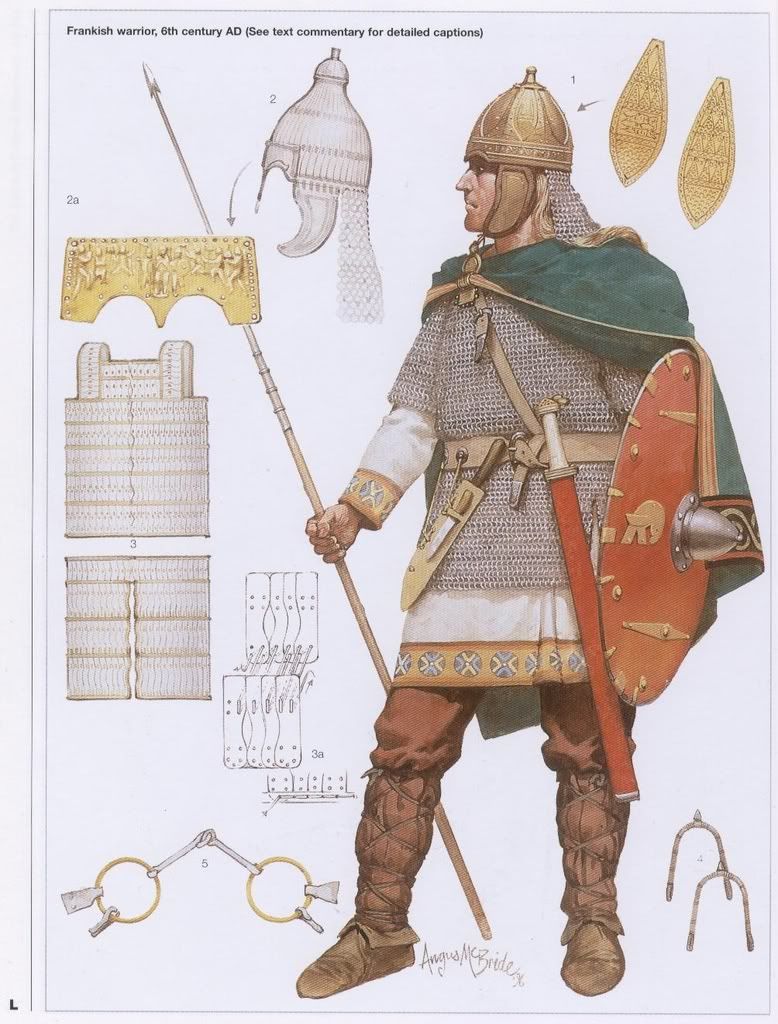
So in the 10th Century, the urban militias of Paris and towns like Nantes, Bordeaux, Poitiers, Toulouse, Tours etc. would be heavy infantry called centannae, armed with spears, shields, javelins, darts, swords and axes, and backed up by archers. Typical soldiers would wear helmets and many would have mail, others probably textile armor.

The Romano Gallic cavalry was probably armored, at least with a textile armor and a shield, probably with a byrnie as well, and would also carry lance, javelins, darts and a sword. A few would carry bows like Roman Sagitarii
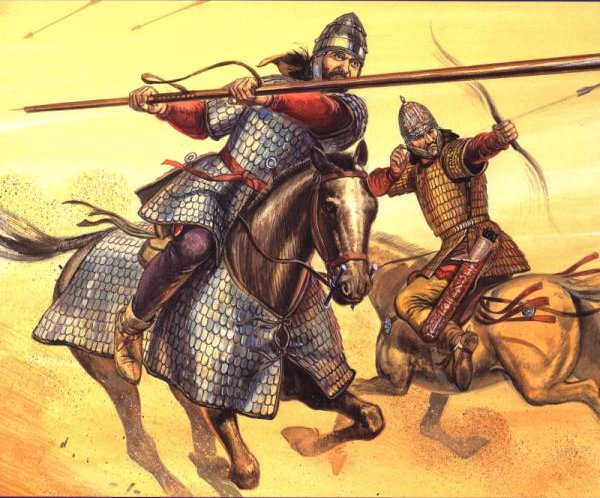
These Cataphracts are kitted out in Asian style, the Alans in Gaul would have probably been clothed and equipped somewhat more similarly to the locals.

The Saromatian (Alan, Taifal) cavalry would be split into light cavalry, some of whom may have had bows, most armed with javelins and darts and light lances, and heavy cavalry with real warhorses some of whom may have had armored horses, body armor (possibly including scale or lamellar armor as Spyrit showed above) axes, light maces, lassos, and lances.
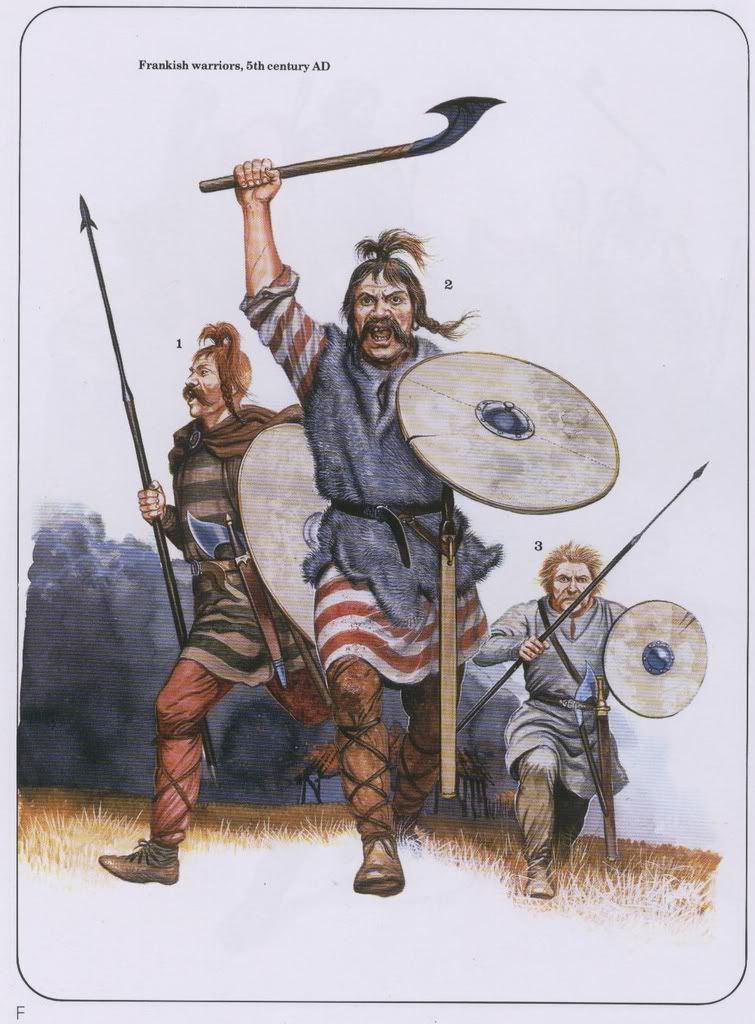
This image depicts Franks from the 5th or 6th Century, Franks in the 10th Century would probably have a more 'medieval' appearance in terms of dress and hair etc., but the weapons were similar.
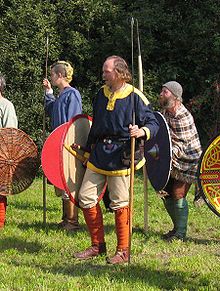
Re-enactors armed with Frankish kit, including angons.
The Germanic tribes would fight primarily as light infantry armed in the more traditional Frankish manner, with the Angon / Francona (a heavy armor-piercing spear probably derived directly from the Roman Pilum) the Francisca, a throwing axe, plus swords and axes.
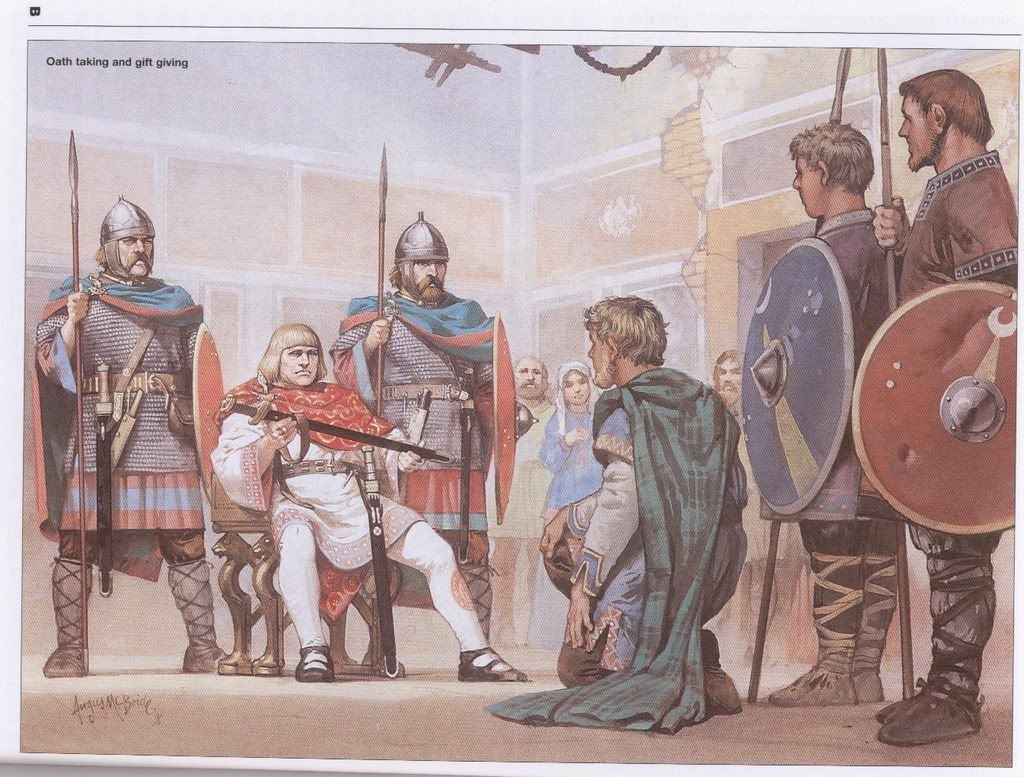
The chieftains would be armored with mail and helmets, and would be accompanied by an elite bodyguard called a Commitatus or Antrustiones. These men would be heavily armed and well mounted but many would prefer to fight as heavy infantry as they did so famously under Charles Martel.
The king himself had both heavy infantry centannae and a large bodyguard of Antrustiones called comes palatii and comes stabuli (palace guards and state police, respectively, some of whom were aristocrats but some of whom were recruited from tribesemen or serfs, creating a new class which came to be called ministerials in the Holy Roman Empire, many ministerials eventually became the founders of the fighting Orders like the Teutonic Order), plus archers and probably Sarmatian cavalry as well.
The best source for the early Franks is Procopius, the best source for the Medieval Franks is (in my opinion) Hans Delbruck. The Osprey books are also, as always, useful particularly for the individual kit.
Amazon.com: History of the Wars, Books V and VI: The Gothic War (Dodo Press) (9781406566550): Procopius, H. B. Dewing: Books
Amazon.com: The Barbarian Invasions: History of the Art of War, Volume II (9780803292000): Hans Delbruck, Walter J. Renfroe Jr.: Books
Amazon.com: Medieval Warfare: History of the Art of War, Volume III (9780803265851): Hans Delbruck, Walter J. Renfroe Jr.: Books
Amazon.com: Warfare and Society in the Barbarian West 450-900 (Warfare and History) (9780415239400): Guy Halsall: Books
Amazon.com: The Age of Charlemagne (Men-at-Arms) (9780850450422): David Nicolle, Angus McBride: Books
Amazon.com: Carolingian Cavalryman AD 768-987 (Warrior) (9781841766454): David Nicolle, Wayne Reynolds: Books
G.
Quick question; in the 10th (so 900s) and 11th century, how did the decentralized Frankish state work? Particularly military-wise, what was the relationship between king and vassal in military matters, the type of troops (and their equipment) and so forth?
So Who Were the Franks
The late Frankish kingdom was a complex society, not really feudal in the 10th Century so much as still mostly tribal. Due to the relative paucity of surviving records we actually know far less about them than we do about the Romans or the later Medieval world. But we do know a few things I can review briefly here.

Charles Martel vanquishes the Moors at Tours in 732 AD
The Frankish top leadership (the Carolingian Dynasty) was very strong in the 8th Century from the victory of Charles Martel at Tours until the early 9th Century when Charlemagne died. During Charlemagnes reign the King of the Franks also became the Emperor of 'Rome'. After Charlemagnes death the Empire was split into three parts and the Frankish kingdom went into a period of decline through the 9th Century under a series of weak leaders with names like Charles the Fat, Charles the Simple and Louis the Stammerer. France was ravaged by the Vikings and fragmented by internal dissent well into the 10th Century. Meanwhile the other two branches of the Empire, Burgundy / Italy and Germany, went into a different direction, sealing the break up of the Frankish Empire into several parts by the late-9th Century. Finally from the early 11th Century the Capetians took over starting with Hugh Capet, which was a new stronger dynasty leading into the Medieval Kingdom of France. So that is the top leadership, complex enough to be sure, but that is actually the simplest part.
Probably the most important fact to keep in mind about the Franks is that they were not an ethnic group per se, or a tribe, but a large multi-ethnic tribal confederation. It was the same for all the other famous Barbarian 'tribes' of the Dark Ages.
So the original Franks included the Salii, Sicambri, Chamavi, Bructeri, Chatti, Chattuarii, Ampsivarii, Tencteri, Ubii and Batavi (Germanic tribes ranging from Germany to Flanders / Holland), one branch of the federation was dominated by the Salii which is why they were known as the Salian Franks. The name Franks probably means 'Free men' which is typcial of such early Germanic federations (the Allemani, which is still the French word for Germans, means literally Alle - Mani or "All men"). As the Frankish tribes conquered Gaul, they heavily intermingled, intermarried and integrated with the Romanized Gauls and picked up many of their habits and gradually, their language. As the Franks expanded they also absorbed other tribes including the Saxons, Alans (Iranian / Persian people), the Taifals (also Iranian), and the Alemanni. This has a lot of significance on the Frankish military.
Frankish tribal law was of the traditional Germanic type, governed by independent "lawspeakers" (called rachimburgs) who spoke at the tribal assembly similar to the Scandinavian 'Ting' and would make legal rulings but did not have direct authority. Judgments were carried out by jurors and tribal Chieftains were elected by the assembly (though the most powerful men were usually elected). Gradually Roman / Oriental style monarchy took hold inside the confederation, which was unified under the Merovingian 'Sea-Kings' and these lawmen were replaced with royal magistrates who were part of an administrative class called centannae or antrustiones (more about them a bit later) who played a similar role, but with loyalty to the King rather than the tribe (somewhat similar to Islamic Qadi).

Frankish Sword
In terms of kit, while the Frankish confederation started out iron-poor, like many Germanic tribal groups, only more so. But by the 10th Century they had actually become one of the greatest iron producing people in the world. Frankish ('Ferrengi') armor and swords were among the most sought-after in the East by this time. So their armies were generally well equipped by the standards of the day, better than most late-Roman armies probably.
Command would break down by Dukes, Bishops, and tribal Chieftains (who would bear similar titles but with less formal meaning). At any one time depending on the strength of the King from 20 -80% of these Princes would fight on the side of the Kingdom. You would also have of course many smaller regional disputes going on between princes.
Political and military organization overlapped, by the 10th Century where you are focusing, the Frankish kingdom was much more sophisticated and organized, but still also pretty decentralized and multicultural, quite complex but you can break it down into four zones.


The City of Carcassone, France, today

Beziers, France, today
In parts of Flanders and the West of France there were many Gallo-Roman trading towns which were almost like smaller versions of Medieval city-states. These walled towns had their own militias made up of a special class of armed burghers called centannae who were called up under what the records refer to as 'local levies' which were well trained and well armed and equipped, like the urban militias of the later Medieval world, mostly as heavy infantry.
Feudalism wasn't very well established in Frankish lands by this point but in Central and Southern France there were some truly feudal fiefdoms based around Latifundia, traditional Roman villa - plantations worked by serfs (pagani), ruled over by Bishops or Dux (Dukes). There were also certain higher nobles such as the Bishop of Paris and the Patrician of Burgundy who held special ranks and often acted as important military leaders with their own heavily armed (cavalry) retinues. These places had Romano-Gallic cavalry but little infantry (unless the 'General levy' was called in which case even serfs 'pauperes' and 'inferiores' would be armed and pressed into service, but that was very rare).
Around the Rhine and the tribes were more barbaric and organized as traditional Germanic light infantry equipped similarly to the Franks of a much earlier time.
Finally the Alans and Taifals were settled in certain areas of France. These Iranian / Saromatian nomads fought as light or as heavy cavalry. In fact there is some argument that they may have introduced the culture of heavy cavalry to France. A Taifal uprising is mentioned in France in 565 AD by Gregory of Tours, so they were still considered a distinct ethnic group by then. The zones controlled by the Central Asians would have been aristocratic areas since they were a foreign people ruling over local tribes. They seem to have assimilated quickly a Taifal Saint was canonized in the 6th Century.

So in the 10th Century, the urban militias of Paris and towns like Nantes, Bordeaux, Poitiers, Toulouse, Tours etc. would be heavy infantry called centannae, armed with spears, shields, javelins, darts, swords and axes, and backed up by archers. Typical soldiers would wear helmets and many would have mail, others probably textile armor.

The Romano Gallic cavalry was probably armored, at least with a textile armor and a shield, probably with a byrnie as well, and would also carry lance, javelins, darts and a sword. A few would carry bows like Roman Sagitarii

These Cataphracts are kitted out in Asian style, the Alans in Gaul would have probably been clothed and equipped somewhat more similarly to the locals.

The Saromatian (Alan, Taifal) cavalry would be split into light cavalry, some of whom may have had bows, most armed with javelins and darts and light lances, and heavy cavalry with real warhorses some of whom may have had armored horses, body armor (possibly including scale or lamellar armor as Spyrit showed above) axes, light maces, lassos, and lances.

This image depicts Franks from the 5th or 6th Century, Franks in the 10th Century would probably have a more 'medieval' appearance in terms of dress and hair etc., but the weapons were similar.

Re-enactors armed with Frankish kit, including angons.
The Germanic tribes would fight primarily as light infantry armed in the more traditional Frankish manner, with the Angon / Francona (a heavy armor-piercing spear probably derived directly from the Roman Pilum) the Francisca, a throwing axe, plus swords and axes.

The chieftains would be armored with mail and helmets, and would be accompanied by an elite bodyguard called a Commitatus or Antrustiones. These men would be heavily armed and well mounted but many would prefer to fight as heavy infantry as they did so famously under Charles Martel.
The king himself had both heavy infantry centannae and a large bodyguard of Antrustiones called comes palatii and comes stabuli (palace guards and state police, respectively, some of whom were aristocrats but some of whom were recruited from tribesemen or serfs, creating a new class which came to be called ministerials in the Holy Roman Empire, many ministerials eventually became the founders of the fighting Orders like the Teutonic Order), plus archers and probably Sarmatian cavalry as well.
The best source for the early Franks is Procopius, the best source for the Medieval Franks is (in my opinion) Hans Delbruck. The Osprey books are also, as always, useful particularly for the individual kit.
Amazon.com: History of the Wars, Books V and VI: The Gothic War (Dodo Press) (9781406566550): Procopius, H. B. Dewing: Books
Amazon.com: The Barbarian Invasions: History of the Art of War, Volume II (9780803292000): Hans Delbruck, Walter J. Renfroe Jr.: Books
Amazon.com: Medieval Warfare: History of the Art of War, Volume III (9780803265851): Hans Delbruck, Walter J. Renfroe Jr.: Books
Amazon.com: Warfare and Society in the Barbarian West 450-900 (Warfare and History) (9780415239400): Guy Halsall: Books
Amazon.com: The Age of Charlemagne (Men-at-Arms) (9780850450422): David Nicolle, Angus McBride: Books
Amazon.com: Carolingian Cavalryman AD 768-987 (Warrior) (9781841766454): David Nicolle, Wayne Reynolds: Books
G.
Last edited:
Galloglaich
First Post
The Fencing Fraternities
This is an interesting and amusing first hand account of a sort of 'peoples fencing tournament' in the 16th Century of the type put on by the fechtschules or fencing fraternities of Central Europe. Just goes to show you, right when you think you won and are ready to go to the pub, somebody shows up and splits your nose for you. This kind of an event was an anachronism in the second half of the 16th Century and it also gives us a glimpse into an earlier time, during the rise of the fechtschules over 100 years earlier in the 15th.
Source blog:
Kampf Kunst: What exactly were the Fechtschulen?
G.
This is an interesting and amusing first hand account of a sort of 'peoples fencing tournament' in the 16th Century of the type put on by the fechtschules or fencing fraternities of Central Europe. Just goes to show you, right when you think you won and are ready to go to the pub, somebody shows up and splits your nose for you. This kind of an event was an anachronism in the second half of the 16th Century and it also gives us a glimpse into an earlier time, during the rise of the fechtschules over 100 years earlier in the 15th.
Source blog:
Kampf Kunst: What exactly were the Fechtschulen?
In 1583 another Fechtschulen was held this time in Troppau, (Silesia)*, in the present day Czechoslovakia. Hans Ulrich Krafft , on his return home, from his service in the "East", Turkey, where he was jailed in Bankrott for 3 years, published his memoirs "Reisen und Gefangenschaft" Travels and Captivity. He tells of a earlier Fechtschulen held in Honor of the Marriage of Prince Hans Friederich of Liegnitz, to a sister of Prince Ludwig of Wurtemberg, however the event was not as Lavish an affair as described by the Poet Frischlin's earlier Wedding Celebrations of Prince Ludwig. The Fechtmeister was a Swabian, from Augsburg, by the name of Hans Mamhoffer. Whose Brother Elias was known to Hans Krafft, through their servitude together in Tripoli and in Syria. *
There were more MarxBruder present than Federfechters and they were eager to Fight! With Trumpeters in the Town Square, all the people had their seats with windows thrown open to see this spectacle. Through the streets went men with Armfulls of Swords, Rappiers and Staffs, There were two Royal Spears full of hanging Dussacks, and what's a Fechtschule without them!!!)
All the Parties put their Capes and Swords in a pile. The Fechtmeister was holding onto a wooden Halberd. The trumpets blared, Just then the Old Prince Georgen zum Brigg, who is considered a Father of the Fatherland*, marshalled in the event and together with the Bishops of Preslaw, a pair of Reichs Tallers were offered as the Prize to every winner, so long as Blood was drawn, the loser should live with his shoddyness in defeat. The youthful Dussack fencers got out of control at one point and had to be Halted by the Fechtmeister. So great was their thirst for 2 Gold Tallers (Thaelers, worth about 2 gulden or gold ducats each), but yet they brought little blood and so little Gold was awarded to the Dussack fencers. The Rappiers, Staffs and Longswords however, proved very bloody, and much Gold was awarded.
The best was a Marxbruder , a Schlosser with his strong Handworks and his Stork from above, he landed strikes on their heads. He was awarded two gold tallers and was ready to go to the Pub, just then a short, little Hatmaker, from Nerlingen (Swabia) came at him with Longsword, and gave the Schlosser, the Spitze or point. the Fechmeister halted the fight instantly and said " Landsman, whats with this Reckless and wild Start? have you not seen, that he who is without Art only stabs at the Head. The reply was: Ich Lieg noch nitt. or "Sorry, I don't lie still".
This response could be compared to the earliest known Handwritten German fechtkunst history and is attributed to Liechtenauers statement in 1389: Wer do Liegt, der ist tot, wer sich Ruret, der lebt noch. Who stays still is dead, who moves still lives.* As no blood was drawn, the match continued with the little Hatmaker, splitting the Marxbruder's Nose in two! For all to see. So, off to the Pub He went!! Then there came an accidental retalliation, a Marxbruder, while Staff fighting, put out an eye of a Federfechter! And the sight of how high the clear, eye fluid went was horrible to behold.*
G.
All good fun. Sadly ruined for us today by OSH regulationsThis is an interesting and amusing first hand account of a sort of 'peoples fencing tournament' in the 16th Century of the type put on by the fechtschules or fencing fraternities of Central Europe. Just goes to show you, right when you think you won and are ready to go to the pub, somebody shows up and splits your nose for you. This kind of an event was an anachronism in the second half of the 16th Century and it also gives us a glimpse into an earlier time, during the rise of the fechtschules over 100 years earlier in the 15th.
Source blog:
Kampf Kunst: What exactly were the Fechtschulen?
G.
Galloglaich
First Post
Speaking of tournaments and fechtshules, this is an excellent promo video just put out by Fechtschule Gdansk, a modern Renaissance fencing club from Poland (in Gdansk, formerly Danzig, which you can see a nice drawing of what it looked like in the 15th Century in the opening shot of the clip)
These guys are some of the best HEMA practitioners in the world today and most of this footage is from a live-steel tournament they recently had. You will see Axel Petterson of GHFS Sweden in there quite a bit as well, another one of the worlds best longsword fencers from one of the top schools. This video really gives you an idea how far HEMA has come in the last ten years.
[ame=http://www.youtube.com/watch?v=H7aXtzf7-Lk&feature=email&email=comment_reply_received]YouTube - Fechtschule Gdańsk 2010[/ame]
It will be interesting to see where we are with it by say, 2015, we may even be ready for the zompoc.
G.
These guys are some of the best HEMA practitioners in the world today and most of this footage is from a live-steel tournament they recently had. You will see Axel Petterson of GHFS Sweden in there quite a bit as well, another one of the worlds best longsword fencers from one of the top schools. This video really gives you an idea how far HEMA has come in the last ten years.
[ame=http://www.youtube.com/watch?v=H7aXtzf7-Lk&feature=email&email=comment_reply_received]YouTube - Fechtschule Gdańsk 2010[/ame]
It will be interesting to see where we are with it by say, 2015, we may even be ready for the zompoc.
G.
Similar Threads
- Replies
- 2
- Views
- 5K
- Replies
- 5
- Views
- 7K
- Replies
- 5
- Views
- 6K
- Replies
- 14
- Views
- 9K
- Replies
- 0
- Views
- 8K
